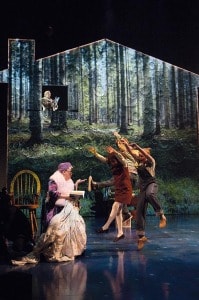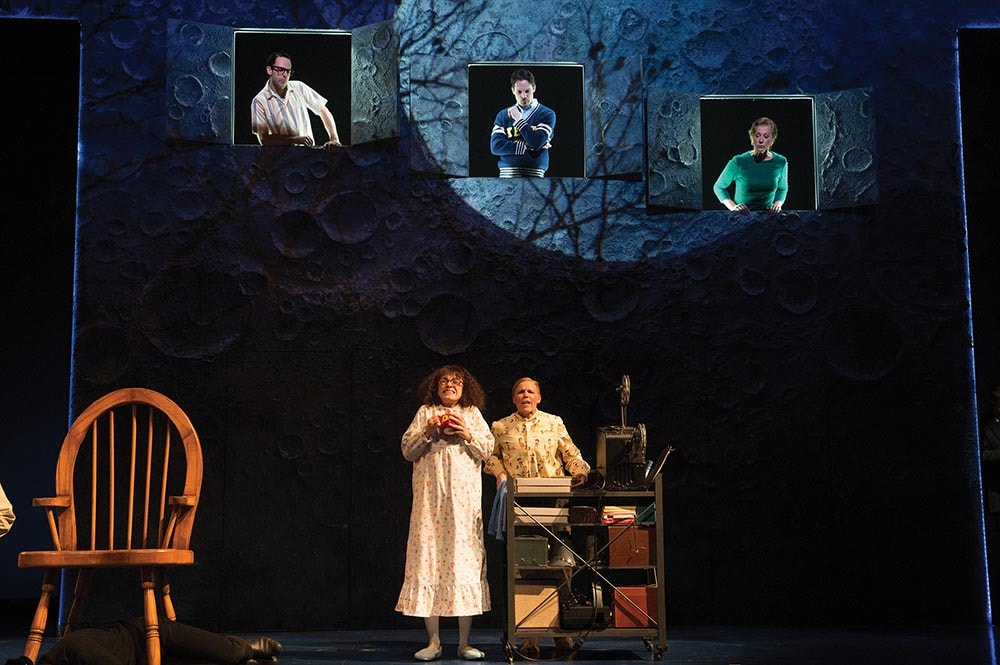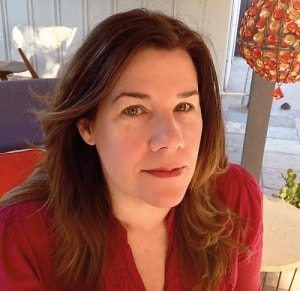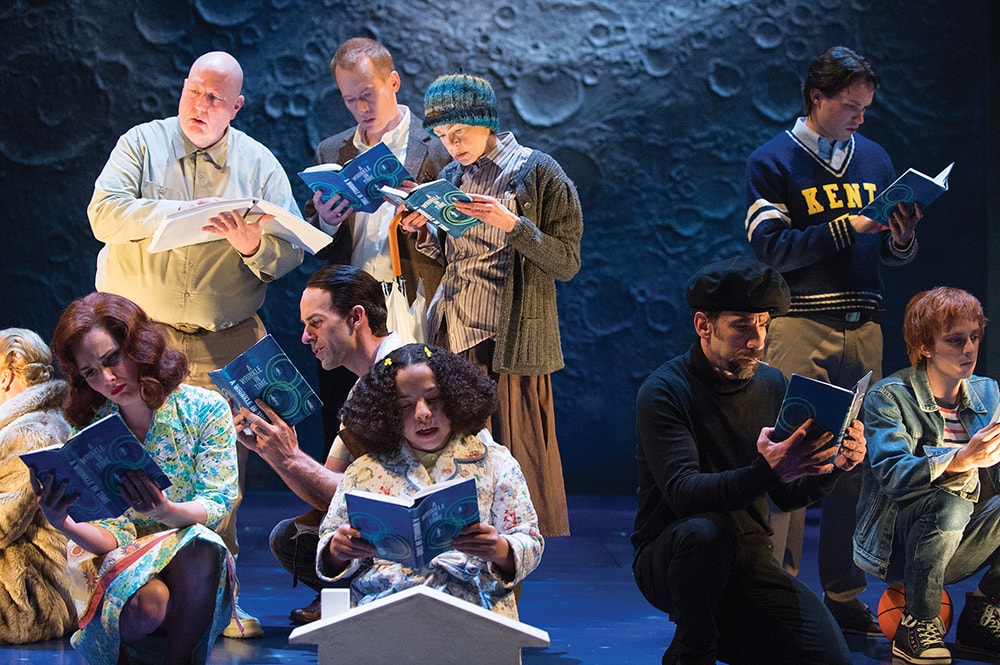If anybody invited you to go to a newly discovered galaxy, would you go? I would. It’s a wonderful way to meet new and exciting people. —Madeleine L’Engle, 1997
In retrospect, a tesseract might have been useful.
When writer/director Tracy Young was confronted by the umpteenth well-wishing, head-scratching fan convinced that what she was attempting could simply not be done, it might have been handy to be able to cheat time—to glimpse just how her in-progress stage adaptation of a beloved, galaxy-hopping sci-fi novel would actually turn out. Or, better yet, instead of tessering herself into the future, Young could have just opened up that wrinkle and sent her dubious questioners through it to discover for themselves how Madeleine L’Engle’s classic A Wrinkle in Time could live onstage.

Then again, Young would probably consider either maneuver an unfair shortcut, not to mention an unfortunate one. If nothing else, she is an artist/explorer who relishes the journey as much as the flag-planting. And this particular journey has taken Young, a Los Angeles native schooled in the Bay Area, not across the universe but back to the Oregon Shakespeare Festival, where her adaptation of L’Engle’s much-beloved 1962 novel had its world premiere in April and runs through Nov. 1.
Mention A Wrinkle in Time and you’re bound to alert a bevy of science- and math-loving dreamers who tracked the steps of Meg Murry, her genius younger brother Charles Wallace and their friend Calvin O’Keefe across the cosmos in search of Meg’s father, a physicist who was working on a top-secret government project before he went missing. Young isn’t the first to attempt the challenge of adapting it: There was recently an opera as well as a 2003 TV movie, produced by Disney, that L’Engle reportedly hated. Before her death in 2007, the author gave her blessings to multiple stage adaptations, particularly when schools wanted to take a run at it. John Glore’s adaptation for California’s South Coast Repertory premiered in 2010 and has found some success across the country. And there’s perennial talk of a Disney remake, this time for the big screen.
But for the OSF version, which the company commissioned, Young, who once contemplated a film career, was challenged to build it “out of the box.” “Technology now exists to present, fully realized, anything in that book,” she says. “But if you took that route, the viewer wouldn’t need to use his imagination to fill in the gaps.”
That’s all well and good, but Wrinkle is still a property with a Harry Potter–like fan base that doesn’t want to see it messed with. And, in a place like Ashland, where the festival is the city, everyone, tourist and local, is up in your business. And they have opinions.
“There was a donor here who said, ‘I don’t think it can be done. Here’s $10,000,’” Young reports with a grin. “In a way, it’s like, ‘Yeah, give it a try. I don’t think you can do it, but I’m going to support it anyway because I loved the book,’” she recalls. “That got my excitement going: We’re going to try to do this, and see what we can get.”
She might even have considered that donation, and the qualifying remark, a kind of a wager or a dare. But by now, people should know better than to wager against the creative prowess of Tracy Young.

“When I think of a Tracy Young show, I think of a very ensemble-based, ensemble-driven, muscular, visually impactful, fun and imaginative world,” posits Christopher Acebo, an associate artistic director at OSF and the scenic designer for Wrinkle. He thinks the show “in a lot of ways takes her back to her Actors’ Gang days.”
Indeed, a Young-directed show is frequently a creative reunion, especially at OSF, where former Cornerstone Theater Company artistic director Bill Rauch, OSF’s artistic director since 2007, has gathered many of his former company members and co-conspirators from his days with Cornerstone in L.A. Among the Wrinkle cast members are Daniel T. Parker and Kate Mulligan, who Young met more than 25 years ago when all three were at the Actors’ Gang in Los Angeles. Likewise, Acebo and puppet designer Lynn Jeffries are both Cornerstone veterans.
It was during her years at the Actors’ Gang that Young found a kindred spirit in Rauch. Adapting classic dramatic works into community-specific projects that used non-professional actors alongside pros, Cornerstone spent the 1990s exploring multiple communities of Los Angeles and beyond. Young was tapped to direct Cornerstone’s Candude, and then the two companies combined to present the first production of Medea/Macbeth/Cinderella, a side-by-side, three-ring-circus rendition of Euripides, Shakespeare and Rodgers and Hammerstein, co-adapted and co-directed by Young and Rauch. The play has had subsequent remounts at Yale Repertory Theatre and OSF.

“I really enjoy long-term collaborations,” says Young, whose résumé bears this out—at the Gang, she was resident director and helped with fundraising for more than a decade, then took on an overlapping associate artist stint with Cornerstone. Young also worked with Secret City pioneer Chris Wells and with Anne Bogart’s SITI Company. Now happily nomadic, she goes where the work takes her. Her first immediate post-Wrinkle gig was a production of The Merry Wives of Windsor for the Idaho Shakespeare Festival.
“It’s fun to go to regional companies with great leadership and good camaraderie so you can get into a good creative flow and make the work,” she enthuses. “I’ve never tried to plan anything—stuff just comes my way. It’s good for me, this leaf-blown-in-the-wind thing.”
“Every time I work with her, she demands that you challenge yourself more than you did the last time,” says Daniel T. Parker, who plays Aunt Beast, among other roles, in Wrinkle, and has worked with Young for decades. “She’s very much, ‘That was great what you did—what else is there?’ That quality is really helpful in a play like this, especially with the Aunt Beast character: She’s blind, she has tentacles, she’s male and female, all these things.”
Fan base expectations notwithstanding, consider some of the other wonders contained in the book. The inventory includes space and time travel to planets populated by giant disjointed brains, and a hermaphroditic creature with healing tentacles; spectacles that appear, Cheshire Cat–like, before their wearer; a formless black mass signifying pure evil; people in suspended animation; a man with satanic red eyes and an apple-faced old woman who transforms into a centaur.
Young and the OSF Wrinkle in Time design team managed to pack pretty much every item on that list into their 100-minute production. For good measure, they even brought in Fortinbras, the Murrys’ loyal (if largely superfluous) dog. They accomplished this with a canny mixture of technical theatricality and the vision of a director steeped in the world of street-theatre ingenuity. Disney, if they ever try again, can tackle the special-effects part.
That said, the OSF Wrinkle has by no means been assembled on the cheap. There is plenty of “ooh! aah!” fodder.




